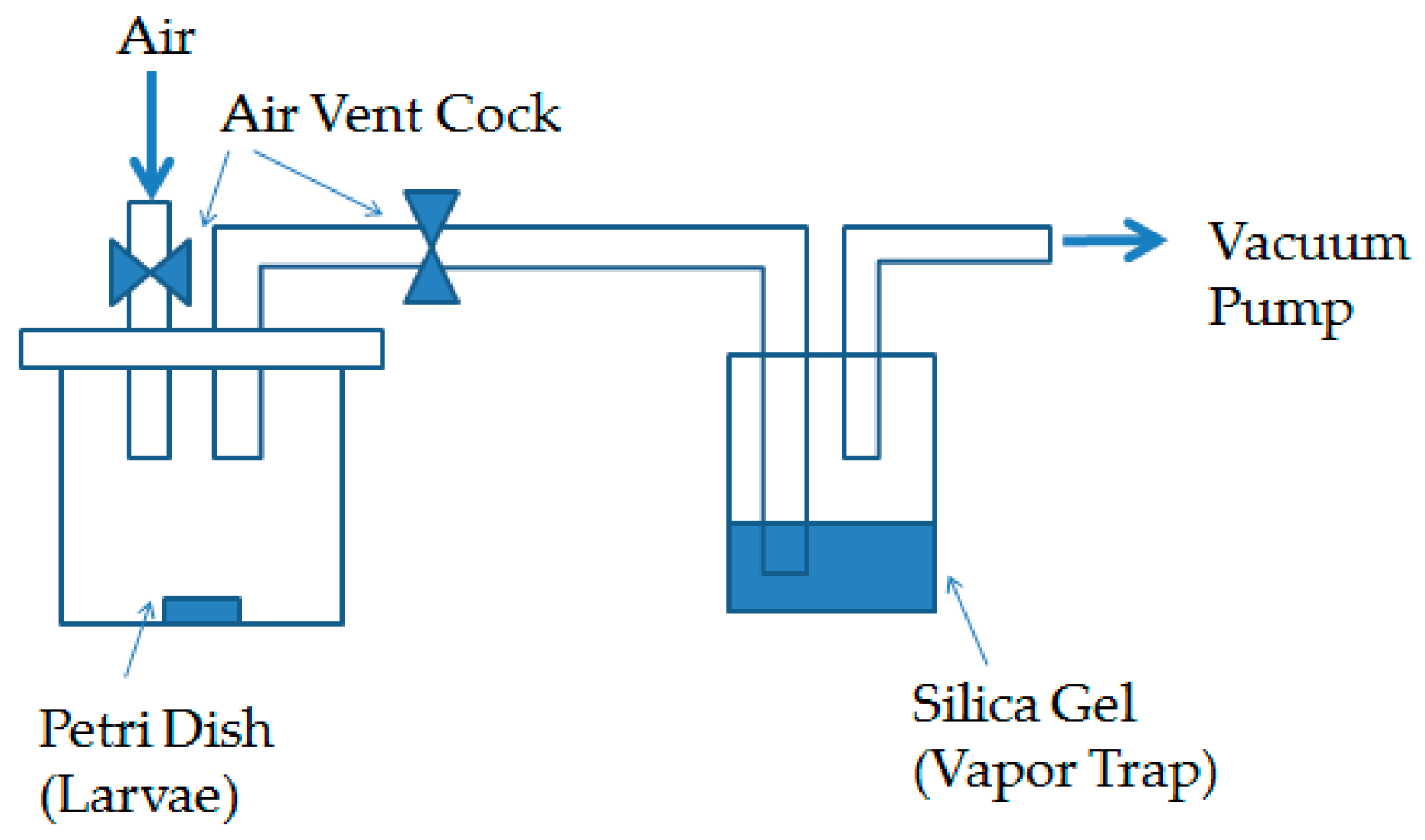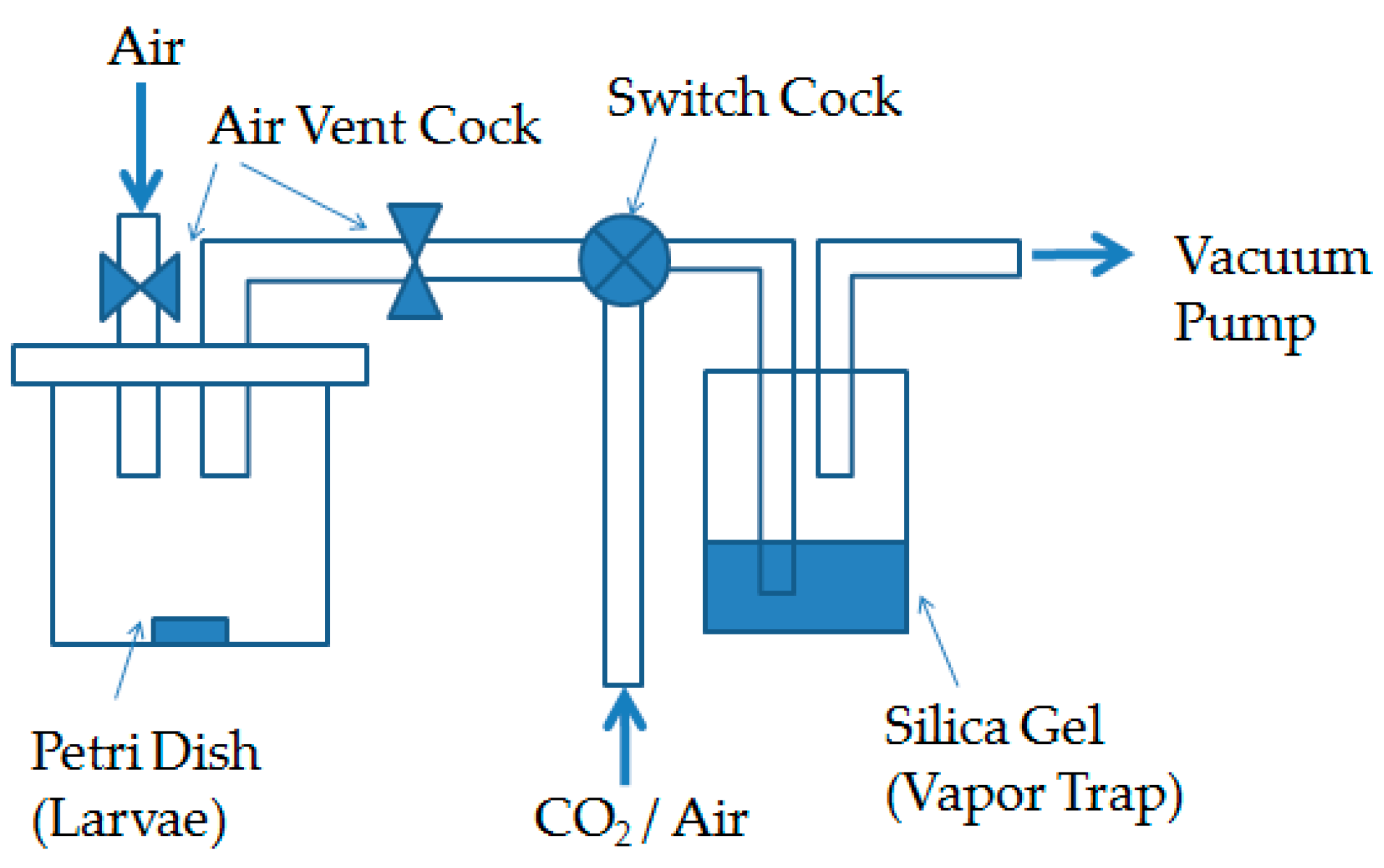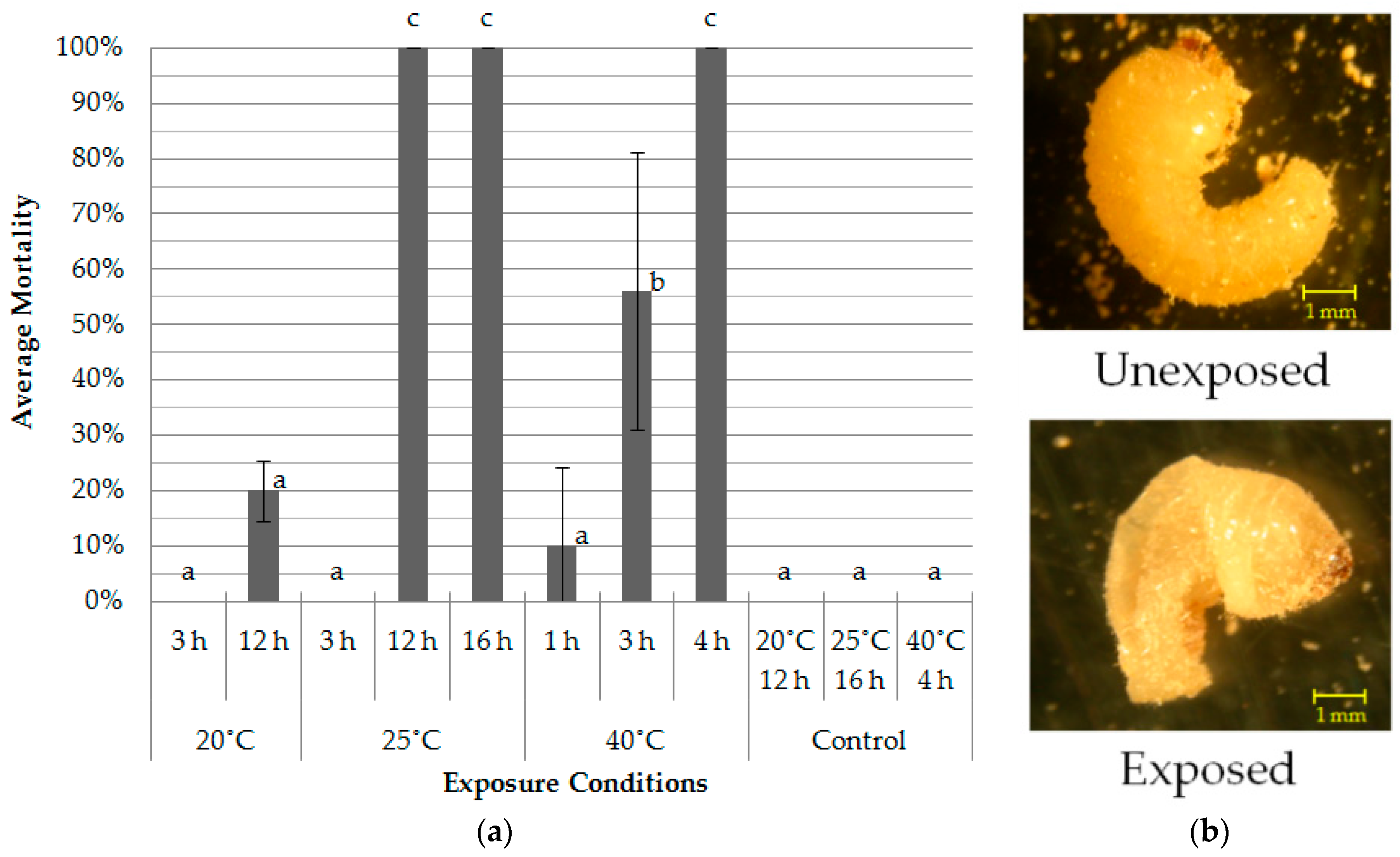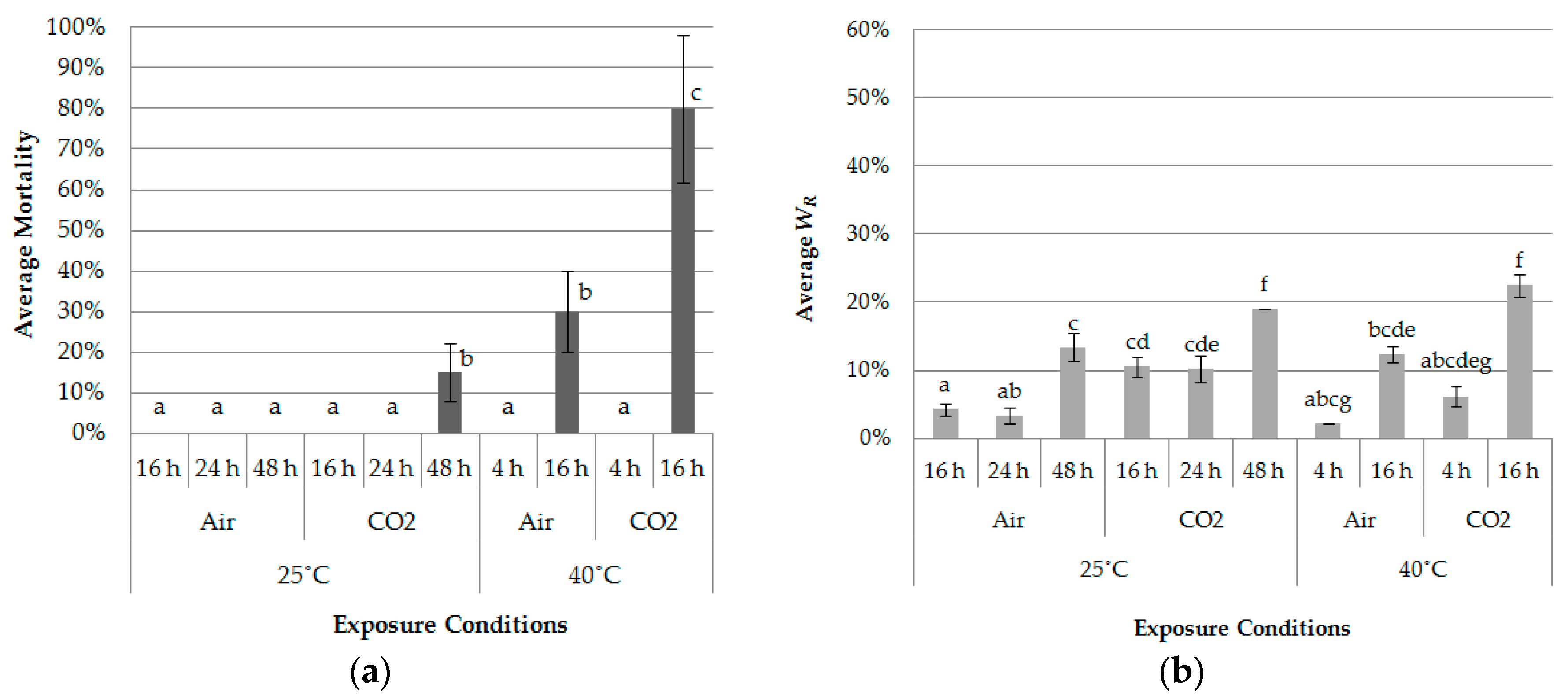Effects of Decompression Treatment for Controlling the Powderpost Beetle, Lyctus africanus Lesne, (Coleoptera: Lyctinae)
Abstract
:1. Introduction
2. Materials and Methods
2.1. Insects
2.2. Weight Reduction Rate of Larvae
2.3. Experimental Apparatus and Decompression Treatment
2.3.1. Experimental Apparatus and Conditions
2.3.2. Treatment in the High Vacuum Condition
2.3.3. Treatment in the Low Vacuum Condition
2.3.4. Evaluation of Effects of Decompression Treatments on L. africanus
2.4. Comparison of Effects of the High Vacuum Treatment on the Mortality of L. brunneus
2.5. Statistical Analysis
3. Results and Discussion
3.1. Moisture Reduction of Larvae by Heat Treatment
3.2. Lethal Condition at High Vacuum Treatment
3.3. Effects of Low Vacuum Treatment
3.4. Comparison of Effects of the High Vaccum Treatment against L. africanus and L. brunneus
4. Conclusions
Acknowledgments
Author Contributions
Conflicts of Interest
References
- Bennett, G.W.; Runstrom, E.S.; Wieland, J.A. Pesticide use in homes. Bull. Entomol. Soc. Am. 1983, 29, 31–40. [Google Scholar] [CrossRef]
- Tsunoda, K. Improved management of termites to protect Japanese homes. In Proceedings of the 5th International Conference on Urban Pests, Singapore, 10–13 July 2005; pp. 10–13.
- Querner, P. Insect pests and integrated pest management in museums, libraries and historic buildings. Insects 2015, 6, 595–607. [Google Scholar] [CrossRef] [PubMed]
- Kigawa, R.; Komine, Y.; Torigoe, T.; Harada, M.; Imazu, S.; Honda, M.; Miura, S.; Kawanobe, W.; Ishizaki, T. Tests on insect eradication of wooden blocks damaged by wood-boring anobiids in historic buildings in Nikko. Sci. Conserv. 2011, 50, 141–155. (In Japanese) [Google Scholar]
- Forbes, C.F.; Ebeling, W. Update: Use of heat for elimination of structural pests. IPM Pract. 1987, 9, 1–5. [Google Scholar]
- Halverson, S.L.; Burkholder, W.E.; Bigelow, T.S.; Nordheim, E.V.; Misenheimer, M.E. High-power microwave radiation as an alternative insect control method for stored products. J. Econ. Entomol. 1996, 89, 1638–1648. [Google Scholar] [CrossRef]
- Hurlock, E.T.; Llewelling, B.E.; Stables, L.M. Microwaves can kill insect pests. Food Manuf. 1979, 54, 37. [Google Scholar]
- Lewis, V.R.; Haverty, M.I. Evaluation of six techniques for control of the western drywood termite (Isoptera: Kalotermitidae) in structures. J. Econ. Entomol. 1996, 89, 922–934. [Google Scholar] [CrossRef]
- Lewis, V.R.; Power, A.B.; Haverty, M.I. Laboratory evaluation of microwaves for control of the western drywood termite. For. Prod. J. 2000, 50, 79–87. [Google Scholar]
- Mahroof, R.; Subramanyam, B.; Throne, J.E.; Menon, A. Time-mortality relationships for Tribolium castaneum (Coleoptera: Tenebrionidae) life stages exposed to elevated temperatures. J. Econ. Entomol. 2003, 96, 1345–1351. [Google Scholar] [CrossRef] [PubMed]
- Nakai, K.; Mitani, T.; Yoshimura, T.; Shinohara, N.; Tsunoda, K.; Imamura, Y. Microwave technology as a non-destructive termite control method—Preliminary results. In Proceedings of the 6th Pacific Rim Termites Research Group, Kyoto, Japan, 2–3 March 2009; pp. 36–40.
- Nakai, K.; Mitani, T.; Yoshimura, T.; Shinohara, N.; Tsunoda, K.; Imamura, Y. Effects of microwave irradiation on the drywood termite Incisitermes minor Hagen. Jpn. J. Environ. Entomol. Zool. 2009, 20, 179–184. [Google Scholar]
- Nelson, S.O. Possibilities for controlling stored-grain insects with RF energy. J. Microwave Power 1972, 7, 231–237. [Google Scholar]
- Pinniger, D. Saving our treasures—Controlling museum pests with temperature extremes. Pestic. Outlook 2003, 14, 10–11. [Google Scholar] [CrossRef]
- Shayesteh, N.; Barthakur, N.N. Mortality and behaviour of two stored-product insect species during microwave irradiation. J. Stored Prod. Res. 1996, 32, 239–246. [Google Scholar] [CrossRef]
- Vadivambal, R.; Jayas, D.S.; White, N.D.G. Determination of mortality of different life stages of Tribolium castaneum (Coleoptera: Tenebrionidae) in stored barley using microwaves. J. Econ. Entomol. 2008, 101, 1011–1021. [Google Scholar] [CrossRef]
- Beaver, R.A.; Sittichaya, W.; Liu, L.Y. A review of the powder-post beetles of thailand (Coleoptera: Bostrichidae). Trop. Nat. Hist. 2011, 11, 135–158. [Google Scholar]
- Peters, B.C.; Creffield, J.W.; Eldridge, R.H. Lyctine (Coleoptera: Bostrichidae) pests of timber in Australia: A literature review and susceptibility testing protocol. Aust. For. 2002, 65, 107–119. [Google Scholar] [CrossRef]
- Gerberg, E.J. Lyctid powder post beetle second only to termite in wood damage. Pest Control 1957, 25, 37–38. [Google Scholar]
- Gerberg, E.J. A Revision of the New World Species of Powder-Post Beetles Belonging to the Family Lyctidae; US Department of Agricluture: Washington, DC, USA, 1957.
- Strang, T.J. A review of published temperatures for the control of pest insects in museums. Collect. Forum 1992, 8, 41–67. [Google Scholar]
- Furukawa, N.; Yoshimura, T.; Imamura, Y. Survey of lyctine damages on houses in Japan: Identification of species and infested area. Wood Preserv. 2009, 35, 260–264. (In Japanese) [Google Scholar] [CrossRef]
- Antrim, R.L.; Chan, Y.C.; Crary, J.R., Jr.; Harris, D.W. Method for Obtaining a Purified Cellulose Product from Corn Hulls. U.S. Patent No. 4239906, 16 December 1980. [Google Scholar]
- Navarro, S.; Calderon, M. Integrated approach to the use of controlled atmospheres for insect control in grain storage. In Controlled Atmosphere Storage of Grains; Elsevier Scientific Publishing Company: Amsterdam, The Netherlands, 1980; pp. 73–79. [Google Scholar]
- Kigawa, R.; Yamano, K.; Miura, S.; Maekawa, S. An automated anoxic treatment chamber for cultural objects: A novel system with nitrogen generator. Sci. Conserv. 1999, 38, 1–8. (In Japanese) [Google Scholar]
- Banks, H.J. Recent Advances in the Use of Modified Atmospheres for Stored Product Pest Control. Available online: http://spiru.cgahr.ksu.edu/proj/iwcspp/pdf2/2/198.pdf (accessed on 14 January 2016).
- Rust, M.K.; Kennedy, J.M. The Feasibility of Using Modified Atmospheres to Control Insect Pests in Museums; Getty Publications: Los Angeles, CA, USA, 1993; pp. 104–121. [Google Scholar]





| Treatment Condition | WR * | |
|---|---|---|
| Temperature (°C) | Time (h) | |
| 20 | 12 | 40.74 ± 6.13 a |
| 25 | 12 | 48.71 ± 3.16 a |
| 40 | 1 | 1.31 ± 6.01 b |
| 40 | 3 | 15.80 ± 16.20 bc |
| 40 | 4 | 35.24 ± 1.07 ac |
| Species | Mortality | WR * |
|---|---|---|
| Lyctus africanus | 100 ± 0 | 35.24 ± 1.07 a |
| Lyctus brunneus | 100 ± 0 | 36.17 ± 0.42 a |
© 2016 by the authors; licensee MDPI, Basel, Switzerland. This article is an open access article distributed under the terms and conditions of the Creative Commons Attribution (CC-BY) license (http://creativecommons.org/licenses/by/4.0/).
Share and Cite
Nakai, K.; Hiraku, T.; Fujimoto, I.; Yoshimura, T. Effects of Decompression Treatment for Controlling the Powderpost Beetle, Lyctus africanus Lesne, (Coleoptera: Lyctinae). Insects 2016, 7, 36. https://doi.org/10.3390/insects7030036
Nakai K, Hiraku T, Fujimoto I, Yoshimura T. Effects of Decompression Treatment for Controlling the Powderpost Beetle, Lyctus africanus Lesne, (Coleoptera: Lyctinae). Insects. 2016; 7(3):36. https://doi.org/10.3390/insects7030036
Chicago/Turabian StyleNakai, Kazushi, Tatsuya Hiraku, Izumi Fujimoto, and Tsuyoshi Yoshimura. 2016. "Effects of Decompression Treatment for Controlling the Powderpost Beetle, Lyctus africanus Lesne, (Coleoptera: Lyctinae)" Insects 7, no. 3: 36. https://doi.org/10.3390/insects7030036






